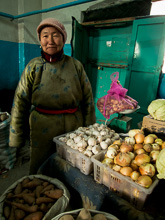The Market
Here is a first installment on the hub of Khovd's economy, one fenced city block bounded by two east-west and two north-south roads, just less than a quarter mile on a side. Although I've heard it called several names, including the
Black Market and the
Big Market, most people here just call it
the market. It's where people here find most of what they need, from keys to cars and cabbage to coal. On this quick tour my goal is show you that
The Market here comes much closer to being a commodities market rather than a super market or shopping mall. Although there are many vendors, there is not a very big distinction between one and another, and yet a few, through a slightly different product line or better presentation, get to claim us as repeat customers. Some have bigger carrots than others, some have firmer turnips. But is is also true that some are much more friendly to us, and make it easier for us to buy from them.
The Market is divided into two halves, the
Free Market (in this former Soviet satellite, I'm already treading on political territory, though not as much as at home) and the
Pay-50₮-To-Get-In-Market. The
Pay Market has housewares, clothing, office supplies, custom tailors, hardware, building supplies, lots of candy, and imported cosmetics. The
Free Market has most everything else, along with housewares, clothing, office supplies, custom tailors, hardware, building supplies, lots of candy, and imported cosmetics, though not with quite as good of a selection as the
Pay Market. The
Free Market also has animal skins, car parts, coal, cow dung, fresh vegetables, furniture, lumber, meat, and wholesale flour and rice. And much more. The Pay Market is also usually more crowded. Each has a separate entrance.
On our first day in Khovd, our English-speaking hosts brought us to The Market because, frankly, there is no way to avoid it. "Just be careful is all I'm saying..." is the advice one of them gave me, as well as "You should really get better with Mongoian money." It took several weeks to get to the point where we could even find our way around, and a couple more before handling tugrugs, tens of thousands of them at a time, did not cause some level of panic. This collection of images won't convey the size or maze-like character of the market. It may help you when you start to say to us "Surely you can find a..." Among the things we have not found here are table knives, salt or pepper shakers, and right now, peanut butter.
More...
Eventually, we have come to see the order of the market. If you are looking for kitchen supplies you head to the south end of the Pay Market. If you are looking for vegetables, now that it is so far below freezing, you head to the block building at the southwest corner of the Free Market. Clothing is at the western edge inside the Pay Market. Throughout there is one fact that will seem more remarkable than all the rest—except when freezing would ruin merchandise, the shops are outside, unheated, and tended by people who stand outside all day long in temperatures that, this month, barely get above 0°F. These "shops" are opened in the morning by bringing everything out front and putting it on display. At night, everything is packed up again, stored without heat overnight for the next day. Both markets are open every day except Thursday, a fact that takes some time to get used to.
Most of the shops are made from used shipping containers or used fuel and chemical tanks with doors torched out of one end, hinges welded on, with a large padlock attached for security. There are a few large buildings that are heated, offering table space for vendors. And especially on the east side of the Free Market there are a few rows of small brick shops, which seem to be mostly used clothing and boots, as well as some small diners.
Photographing here has taken much more time than it seems like it should. For several reasons, and not just the fact that we don't speak Mongolian, we stand out here, so there is no way to photograph unobtrusively. Although I sometimes hold the camera up and gesture to it for permission, in several situations I've taken the much slower approach of trying to get to know a few people by going back again to buy from them. Eventually, they seem happy to see me, even with a camera. Once I give one person a print of themselves, they show it to others, who then ask me to take their portraits. One problem with this approach, at least in the vegetable vendors building, has been having so many eager people lined up that we can't buy groceries. I normally just give the prints away in appreciation for what the people are giving me, but photography here seems to be much more valued than it is at home. Several women have insisted on paying me, and that is how I have come to accept my first photography payment in cabbages and turnips.
The other problem with this method is that even in Khovd's Big Market, people are self-conscious and very aware of how they would like themselves to look. Much of the time they are giving me instructions about what they want to be included in the picture. And every once in a while, we must still wait for lip stick.
Show Less...

